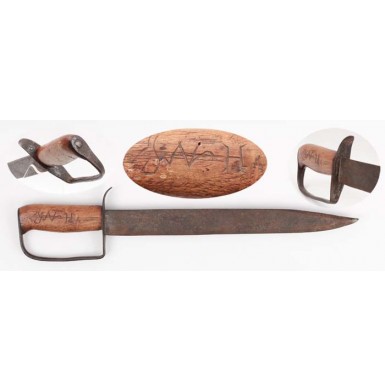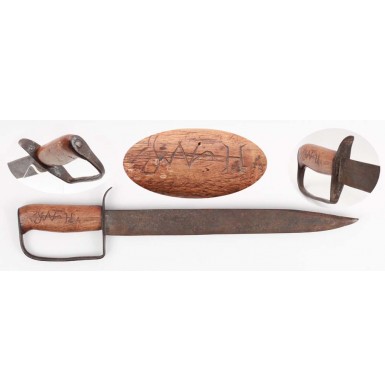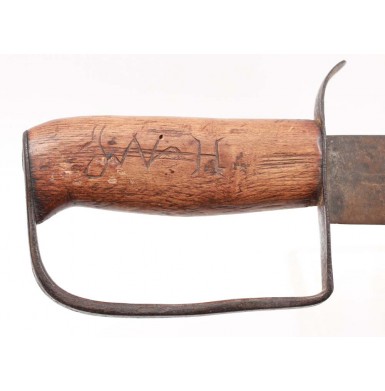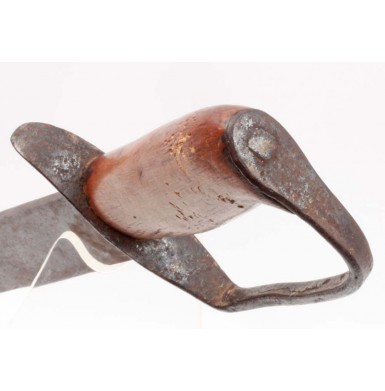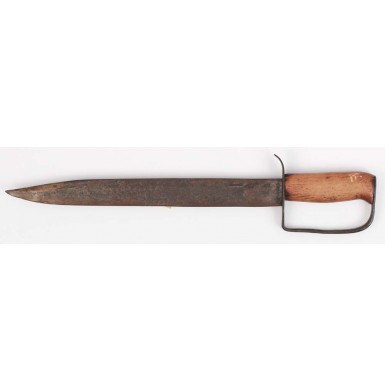Confederate D-Guard Bowie with NC Identification
- Product Code: EWSK-1298-SOLD
- Availability: Out Of Stock
-
$1.00
There is probably no more iconic Civil War image than that of the young Confederate soldier, heading off to war with an absurdly large fighting knife in his hand or on his belt. Early war southern ambrotypes and tintypes provide us a dizzying array of large, wicked, and sometimes comical fighting knives of all descriptions, usually made by local blacksmiths for the boys of 1861 to take to war. Over the years, the majority of these local knife makers have remained anonymous, although sometimes certain traits and characteristics of surviving knives can help us to make general statements about the likely region or state that an unmarked knife may have originated in. More recent scholarship has allowed us to identify some knives as to their maker, even though they bear no markings. The classic southern fighting knife was usually overly large and robust, with an overall length that typically ranged between 12” and 24” and with blades that varied from about 8” to over 18”! The blades themselves were often very thick, varying from just .20” to over .35” in thickness at the spine, near the ricasso.
This knife was produced by an unknown southern blacksmith, who tried to produce a functional fighting knife that was not quite as bulky and heavy as some that we encounter today. The knife is a classic local blacksmith made knife. The hammer-welded iron D-guard shows wonderful blacksmith hammer marks and under good magnification the folded layers of the iron that make up the guard are clearly visible. The knife does not quite rise in quality to the level of what some Confederate knife authorities now call “factory made knives”, giving that designation to the better made, and yet still totally anonymous Confederate bowies. While the knife is from an unidentified maker it does have characteristics that are similar to other known examples of Confederate knives. The one-piece wooden grip has a very unique angled shape to it at the rear, where it joins the D-guard at the pommel cap. This same shape and design is pictured on an unknown maker, barn found knife illustrated in the new book Confederate Bowie Knives by Jack Melton, Josh Phillips & John Sexton. The knife is pictured on page 213 of the book, and is from the famous Steve Mullinax collection. The knife was found in a barn in Crabapple, GA and has no further known history. This knife may shed some light on the origin of that one, as this one is descended directly from the family and the initials of the man who carried it are carved on the grip.
This knife came to the market very recently, when it was sold by the Great, Great, Grand-Nephew of the man who carried it. The owner could not provide the regiment to which his relative belonged, but did know that the man who carried the knife was “J A Hancock” who lived in Randolph County, North Carolina in the Asheboro area. He further stated that Hancock went by his middle name “Abijah”, and he could not remember what his relative’s first name was. Research into the US Census of 1860 and Confederate service records provided substantial evidence that “J. A. Hancock” was Joseph A Hancock of Randolph County, NC. The 1860 Census shows that Joseph A Hancock was born in 1844 and was 16 years old in 1860. He lived with his father (also named Joseph), his mother Katherine, three sisters and one brother. At 16, Joseph was the 2nd oldest child with his sister “Katherine Jr” being the oldest at 21 and his little sister Manda being the youngest at 5. As Joseph’s father had the same name, it would have been very common for him to be referred to by his middle name, to avoid confusion. Joseph Sr. was originally from Virginia, and was listed in the Census as a “Farm Laborer”, with an estate valued at $60. Further research indicates that Joseph was born on October 18, 1844 and managed to avoid service until he was conscripted into the Confederate Army. According to Confederate service records, on October 23rd (or 25th), 1862, within a week of turning 18 years old, Joseph A Hancock was conscripted into Company H of the 47th North Carolina Infantry at Camp Holmes, by Colonel Mallett. Joseph was one of the replacement troops who were simply sent to fill holes in previously established regiments. The 47th had originally been organized in March of 1862, and the men that originally comprised company H, the “North Carolina Tigers” were from Wake County, NC. During their initial service, the 47th lost a significant number of men to disease, especially while stationed at Camp Magnum near Raleigh, NC. Mumps, measles and “malarial fevers’ were rampant in the camp and took quite a toll on the regiment. From the time that he was conscripted, Joseph would remain on the rolls of the 47th NC, although he was not always present for a number of reasons. He was present, however, for some of that regiment’s most terrifying engagements, including Gettysburg. On July 1st, 1863 Joseph was wounded during the first day’s fighting. This was probably a strike of amazing luck for young Joseph, as his regiment (as part of Pettigrew’s Brigade) would suffer tremendous losses on July 3 during Pickett’s Charge. Joseph would spend most of the summer of 1863 in the hospital in the Richmond area, recovering from his wounds. He was admitted to Richmond’s Receiving & Wayside Hospital (General Hospital #9) on July 28, 1863, but I could not find the date of his discharge and return to duty. He apparently returned to his regiment for the fall campaigns and was wounded again on October 14, 1863 at the battle of Bristoe Station. There he received a gunshot wound to the thigh, which was listed as a “flesh wound”. Joseph was sent back to Receiving & Wayside Hospital (General Hospital #9) in Richmond on October 18, 1863 and on October 19th was transferred to Moore Hospital (General Hospital #24) in Richmond. Around November 7th (or 9th depending on the document), 1863, Joseph was given a 60-day furlough to return home, and likely to recuperate from his wounds. His company muster roll shows him as “Absent Without Leave” for January & February of 1864, but that probably is the result of the furlough order not making its way to regimental, let along company command. Joseph was back with his regiment and company by April of 1864, as he received pay at the end of that month (although one modern document suggests that his estimated date of return was May 15, 1864). He received pay again in June of 1864. The pay records suggest that Joseph was likely present for the participation of the 47th NC in the battles of The Wilderness, Spotsylvania Courthouse and Cold Harbor. By the fall of that year Joseph had been detailed to “Extra Duty” as an ambulance driver. In October of that year he was noted as having been rated as “disabled” by the medical board due to his wounds. However, as the situation around Petersburg continued to deteriorate, every available man that could hold a musket was returned to the trenches, and on April 2nd, 1865, Joseph was captured at Petersburg, along with 110 other members of the 47th NC. He was forwarded to City Point, VA and then shipped to Point Lookout, MD where he was interred on April 5, 1865. Joseph took the Oath of Allegiance on June 27, 1865 and made his way home to Randolph County, NC where he lived until Christmas Day, 1912, dying at the age of 68. He is buried in a grave with a simple marker in the graveyard of Mount Zion Methodist Church in the town of Trinity (Randolph County), NC.
This wonderful, identified Civil War fighting knife is a relative lightweight when it comes to Confederate “D-Guards”. It weighs 13 ounces and is 17 1/16” in overall length. The slightly upswept clip-point Bowie blade is 12 5/8” long and the hilt is 4 ““ in length. The blade, as is typical of southern wartime knives, appears to be made from recycled metal, and appears to be high carbon steel created via the hammer welding process. The blade is 1 5/16” wide at the widest point, near the ricasso, and is only .19” 3/16”) thick at the spine. The blade has a 3 ““ long, false edge near the tip, which has been sharpened. The D-shaped knuckle guard is about 1 ““ (on average) from the hilt and is about 4” long. The guard is about 7/8” wide at the widest point, and tapers to about 5/16” wide at the rear of the hilt. The hammer-forged guard is about 3/16” thick, although it varies slightly along its length. The guard forms the pommel cap of the hilt with an oval shape that is about ““ wide. It is integral to the knuckle guard and is secured by peening the tang of the knife through this pommel cap. The upswept quillon of the guard extends about 1 1/8” above the spine of the blade and has an attractive, forward curve. The scales (grip panels) are made from a single piece of light colored, straight-grained hardwood, possibly Yellow Poplar, a common North Carolina hardwood. The grip is about 4 ““ in length, and is about 1 3/8” in height and about 7/16” in width. The grip has a very unique, angled terminus that is well illustrated in the photos below and is nearly identical to that found on the knife from Confederate Bowie Knives referenced above. The grip fits the hand well and the knife is very well balanced. The grip is carved on the obverse with the initials J A H.
The knife is in about VERY GOOD condition. The blade has a lovely, untouched brownish blue patina over the entire blade. The blade still shows lovely speckles of heat bluing from the forging process. The blade is mostly smooth, but does show even scattered areas of light to moderately oxidized salt & peppering and light pinprick pitting. The edge of the blade shows no nicks or damage worthy of mentioning, but does show some light sharpening marks from the period. The edge remains rather sharp, and as noted the false edge has been sharpened as well. The only condition issue worth mentioning is that the very tip of the blade has a minor bend, which is also well illustrated below. This is a very minor issue and the blade has not been broken, repaired or re-tipped. As a generational family knife, it more than likely saw some use a plaything for the descendants of Joseph Abijah Hancock. The blade is totally untouched, uncleaned and as found. The guard has about the same dark bluish brown patina as the blade. It shows wonderful hand forged impact marks and the folded iron that makes up the grip has visible layers under good light and magnification. The wooden grip panels are mostly smooth and are free of any breaks, cracks or repairs. They do show some light handling marks and dings, a few slightly more recent impact marks, again they are likely from youthful play with a piece of family history. The knife is light enough and well enough balanced that it may well have served young Joseph as useful side knife through much of his military career, but was probably left at home after his furlough in November of 1863.
Overall this is a really attractive example of the classic blacksmith made Confederate D Guard Bowie Knife, with an absolutely wonderful history and identification directly to a Confederate soldier who fought valiantly with the 47th NC Infantry from the fall of 1862 through the end of the war. J A Hancock served with distinction, receiving a place on the Confederate Roll of Honor for his wound at Gettysburg and receiving yet another wound at Bristoe Station later that same year. He was captured and spent a short amount of time in the infamous Point Lookout prisoner of war camp, and was not released until more than 2 months after the end of the war. Identified Confederate knives are few and far between and this one has a wonderful history. Included with the knife is a letter of authenticity detailing the story of the knife being sold out of the family and a binder of documents relating to Joseph A Hancock and his service. This is a great North Carolina identified knife with a very unique grip, which may help us to identify a similar knife published knife. This knife will be a fantastic centerpiece to any advance Confederate collection.
Sidebar: While researching the casualties of the 47th NC I discovered that Private Benjamin King of Wake County, NC was wounded at Venus Point, GA on November 15, 1864. King served in Company I of the 47th NC Infantry. Venus Point is only 30 miles from Crabapple, GA and suggests that the unidentified barn-found bowie with the same pattern grip (as shown on page 213 of the new bowie knife book) could well be a North Carolina knife and could have been left behind by King when he was treated for his wounds or recuperated in that very barn. It is certainly worthy of further investigation.
SOLDTags: Confederate, D, Guard, Bowie, with, NC, Identification

